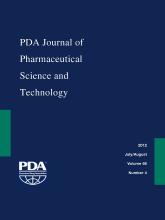Research ArticleResearch
The Application of Uniplex, Duplex, and Multiplex PCR for the Absence of Specified Microorganism Testing of Pharmaceutical Excipients and Drug Products
Suzan M. Ragheb, Aymen S. Yassin and Magdy A. Amin
PDA Journal of Pharmaceutical Science and Technology July 2012, 66 (4) 307-317; DOI: https://doi.org/10.5731/pdajpst.2012.00871
Suzan M. Ragheb
Aymen S. Yassin

References
- 1.↵
- 2.↵
- 3.↵
- Lang D. J.,
- Kunz L. J.,
- Martin A. R.,
- Schroeder S. A.,
- Thomson L. A.
- 4.↵
- Glencross E. J. G.
- 5.↵
- Wilson L. A.,
- Ahearn D. G.
- 6.↵
- Safranek T. J.,
- Jarvis W. R.,
- Carson L. A.,
- Cusick L. B.,
- Bland L. A.,
- Swenson J. M.,
- Silcox V. A.
- 7.↵
- Madani T. A.,
- Alsaedi S.,
- James L.,
- Eldeek B. S.,
- Jiman-Fatani A. A.,
- Alawi M. M.,
- Marwan D.,
- Cudal M.,
- Macapagal M.,
- Bahlas R.,
- Farouq M.
- 8.↵
- Jimenez L.
- 9.↵
- Sutton S.,
- Jimenez L.
- 10.↵
- 11.↵
U.S. Pharmacopeia, Vol. 34; U.S. Pharmacopeial Convention: Rockville, MD, 2011.
- 12.↵
- Greisen K.,
- Loeffelholz M.,
- Purohit A.,
- Leong D.
- 13.↵
- De Vos D.,
- Lim A. Jr..,
- Pirnay J. P.,
- Struelens M.,
- Vandenvelde C.,
- Duinslaeger L.,
- Vanderkelen A.,
- Cornelis P.
- 14.↵
- Hendolin P. H.,
- Markkanen A.,
- Ylikoski J.,
- Wahlfors J. J.
- 15.↵
- Aranda K. R.,
- Fagundes-Neto U.,
- Scaletsky I. C.
- 16.↵
- 17.↵
- 18.↵
- Zhang D.,
- Zhang H.,
- Yang L.,
- Guo J.,
- Li X.,
- Feng Y.
- 19.↵
- Balakrishna K. M. H.,
- Batra H. V.
- 20.↵
- Shylaja R. M. H.,
- Batra H. V.,
- Bawa A. S.
- 21.↵
- Bej A. K.,
- Mahbubani M. H.,
- Miller R.,
- DiCesare J. L.,
- Haff L.,
- Atlas R. M.
- 22.↵
- Bej A. K.,
- Steffan R. J.,
- DiCesare J.,
- Haff L.,
- Atlas R. M.
- 23.↵
- Bej A. K.,
- DiCesare J. L.,
- Haff L.,
- Atlas R. M.
- 24.↵
- 25.↵
- Abd-El-Haleem D.,
- Kheiralla Z. H.,
- Zaki S.,
- Rushdy A. A.,
- Abd-El-Rahiem W.
- 26.↵
- 27.↵
- Sabat G.,
- Rose P.,
- Hickey W. J.,
- Harkin J.
- 28.↵
- Jimenez L.,
- Smalls S.,
- Scalici C.,
- Bosko Y.,
- Ignar R.,
- English D.
- 29.↵
- Jimenez L.,
- Ignar R.,
- Smalls S.,
- Grech P.,
- Hamilton J.,
- Bosko Y.,
- English D.
- 30.↵
- 31.↵
- 32.↵
- Merker P.,
- Grohmann L.,
- Petersen R.,
- Ladewig J.,
- Gerbling K. P.,
- Lauter F. R.
- 33.↵
- Jimenez L.
- 34.↵
- Škof A.,
- Poljak M.,
- Krbavčič A.
- 35.↵
- 36.↵
- Samadi N.,
- Alvandi M.,
- Reza Fazeli M.,
- Azizi E.,
- Mehrgan H.,
- Naseri M.
- 37.↵
- Karanam V. R.,
- Reddy H. P.,
- Subba Raju B. V.,
- Rao J. C.,
- Kavikishore P. B.,
- Vijayalakshmi M.
- 38.↵
- Farajnia S.,
- Hasan M.,
- Nezhadi S. H.,
- Mohammadnejad L.,
- Milani M.,
- Lotfipour F.
- 39.↵
- 40.↵
- Henegariu O.,
- Heerema N. A.,
- Dlouhy S. R.,
- Vance G. H.,
- Vogt P. H.
- 41.↵
- Keer J. T.,
- Birch L.
- 42.↵
- Nocker A.,
- Cheung C. Y.,
- Camper A. K.
- 43.↵
- Casey W.,
- Muth H.,
- Kirby J.,
- Allen P.
- 44.↵
- Wilson I. G.
- 45.↵
- 46.↵
- Tang S.
- 47.↵
- Harris E.
- 48.↵
PDA Technical Report 33. Evaluation, Validation and Implementation of New Microbiological Testing Methods; Parenteral Drug Association: Bethesda, MD, 2000.
In This Issue
PDA Journal of Pharmaceutical Science and Technology
Vol. 66, Issue 4
July/August 2012
The Application of Uniplex, Duplex, and Multiplex PCR for the Absence of Specified Microorganism Testing of Pharmaceutical Excipients and Drug Products
Suzan M. Ragheb, Aymen S. Yassin, Magdy A. Amin
PDA Journal of Pharmaceutical Science and Technology Jul 2012, 66 (4) 307-317; DOI: 10.5731/pdajpst.2012.00871
The Application of Uniplex, Duplex, and Multiplex PCR for the Absence of Specified Microorganism Testing of Pharmaceutical Excipients and Drug Products
Suzan M. Ragheb, Aymen S. Yassin, Magdy A. Amin
PDA Journal of Pharmaceutical Science and Technology Jul 2012, 66 (4) 307-317; DOI: 10.5731/pdajpst.2012.00871
Jump to section
Related Articles
- No related articles found.





